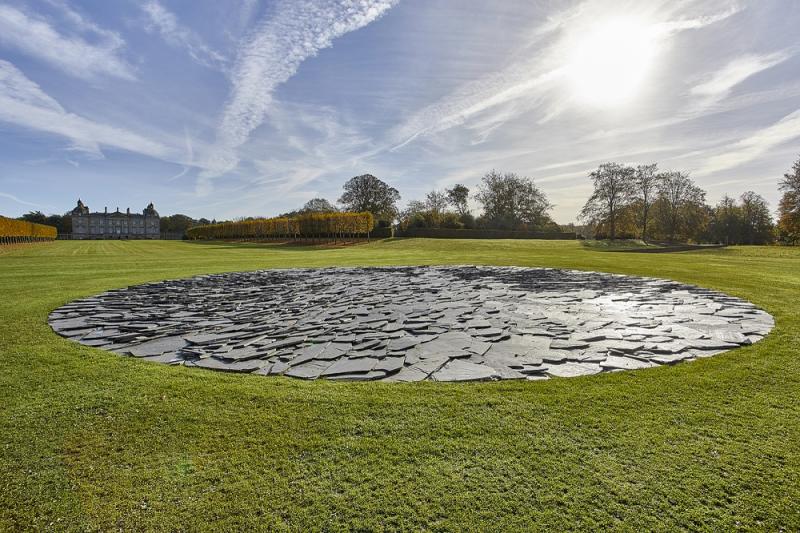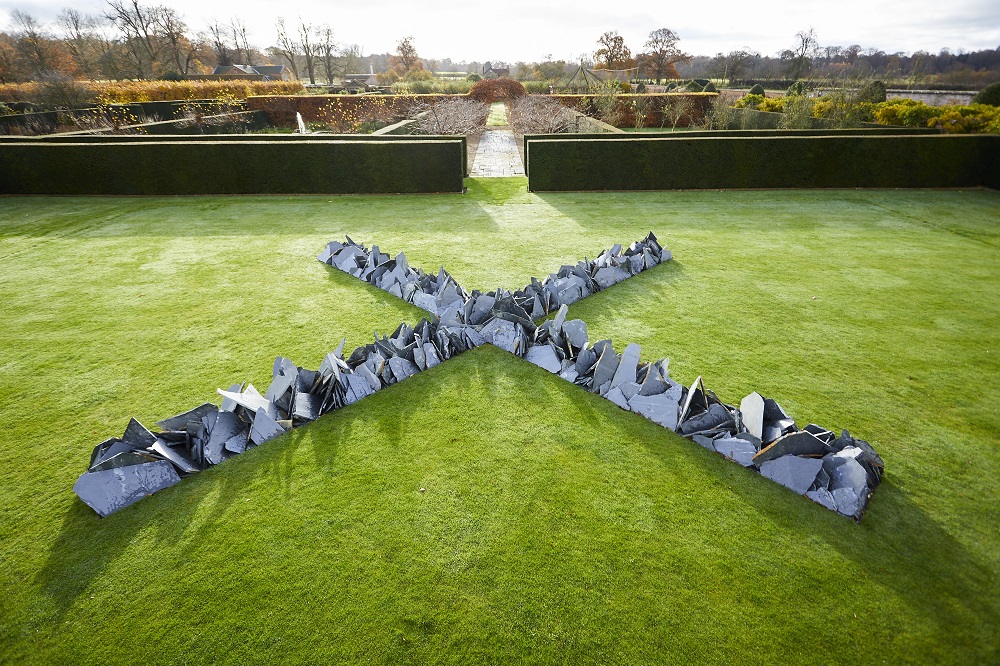Richard Long: Earth Sky, Houghton Hall | reviews, news & interviews
Richard Long: Earth Sky, Houghton Hall
Richard Long: Earth Sky, Houghton Hall
The sculptor uses English materials to take over an 18th-century estate in Norfolk

“I’m a great opportunist,” says Richard Long, a statement that for all its economy brims with contradictions and possibilities. While his sculptures made in wild and far-flung places often look stumbled-upon, incidental, his method is so careful and considered, each gesture so meticulously planned, that opportunism seems hardly the word for it.
His six new works take their place in Houghton’s burgeoning sculpture park, which already features one permanent work by Long from 2003, and pieces by artists including James Turrell, Rachel Whiteread and Anya Gallaccio. It is Long’s biggest exhibition since his Tate retrospective in 2009, and a unique and unprecedented opportunity to experience a group of his outdoor works together. One of the country’s finest examples of Palladian architecture, Houghton Hall was built by Britain’s first Prime Minister Sir Robert Walpole. Set in parkland shaped by classical ideals of line and balance, tempered by a very 18th-century English understanding of the picturesque, it is an embodiment of not just English sensibility but history. Long’s sculptures, made from the stone and wood of England, are very much of this place, although they are not always entirely in harmony with it. The Houghton Cross (pictured above) erupts, its fiercely jagged slates cutting through the immaculate surface of the croquet lawn. It is the contrast between primeval matter, and the impossibly smooth lawn and hedges that surround it, that gives it its raw force.
One of the country’s finest examples of Palladian architecture, Houghton Hall was built by Britain’s first Prime Minister Sir Robert Walpole. Set in parkland shaped by classical ideals of line and balance, tempered by a very 18th-century English understanding of the picturesque, it is an embodiment of not just English sensibility but history. Long’s sculptures, made from the stone and wood of England, are very much of this place, although they are not always entirely in harmony with it. The Houghton Cross (pictured above) erupts, its fiercely jagged slates cutting through the immaculate surface of the croquet lawn. It is the contrast between primeval matter, and the impossibly smooth lawn and hedges that surround it, that gives it its raw force.
The Houghton Line (pictured below) is more nuanced: a line formed of piles of the local Carr stone, an orange-brown material heaped up like an excavation, should surely appear like a wound in the landscape, gouged into the perfect green of the lawn. Instead, bisecting the centre of the house, there is an unexpected symmetry to it, and it seems more like a manifestation of some mystical alignment. In the immaculately designed grounds of Houghton Hall, it is as if centuries of cultivation have been stripped back to expose something elemental beneath.
If the Houghton Line seems to echo with the memory of some ancient leyline or track, it also relates to the walks for which Long has become perhaps best known. The line was paced out by Long, and its very existence and the decisions about its precise situation were borne out of the artist’s walks around Houghton, which he first visited 14 years ago. For the viewer too, the act of walking from piece to piece is intrinsic to the experience, with each sculpture changing as you walk around it, towards it, and away from it. White Water Falls of china clay appear and then disappear behind an arcade, while Full Moon Circle (main picture), slick with rain, looks from a distance like a pool of water, a silvery slash in the grass. As you get closer the piece ripples silver and dark, the slates overlapping like irregular fish scales that undulate as they catch the light. In sunlight, I am told, it changes, and in the moonlight, is different again.
White Water Falls of china clay appear and then disappear behind an arcade, while Full Moon Circle (main picture), slick with rain, looks from a distance like a pool of water, a silvery slash in the grass. As you get closer the piece ripples silver and dark, the slates overlapping like irregular fish scales that undulate as they catch the light. In sunlight, I am told, it changes, and in the moonlight, is different again.
First made in 2003, but now relocated to this central point at Houghton, Full Moon Circle has a clear affinity with the follies that once were plentiful here. Fulfilling a traditional purpose to delight and surprise, Full Moon Circle is both an intrusion into the landscape and at one with it. Of all Long’s works at Houghton, the most exquisite example of this strange tension is found in his circle of upturned tree roots, simultaneously a harmonious rearrangement of natural features in the landscape, and an outrageous perversion of natural order. The trees, apparently rooted in the air, seem to grow downwards into the ground. And yet as remains of trees that fell long ago, on this very ground, White Deer Circle blends unproblematically into the landscape, the deer wearing them down and gradually destroying them by using them as scratching posts.
Like Long’s other sculptures here, there is a sense of some cosmic significance invoked, their henge-like appearance combining with their position on the site of the old village of Houghton to create an eery sense of place. Standing here, on a rainy cold April day, the wonderful vistas of Houghton dissolving into a misty horizon, with no traffic, no passing aircraft and no mobile phone signal, one stands on the edge of the world, as if at the point where earth meets sky.
rating
Explore topics
Share this article
Add comment
The future of Arts Journalism
You can stop theartsdesk.com closing!
We urgently need financing to survive. Our fundraising drive has thus far raised £49,000 but we need to reach £100,000 or we will be forced to close. Please contribute here: https://gofund.me/c3f6033d
And if you can forward this information to anyone who might assist, we’d be grateful.

Subscribe to theartsdesk.com
Thank you for continuing to read our work on theartsdesk.com. For unlimited access to every article in its entirety, including our archive of more than 15,000 pieces, we're asking for £5 per month or £40 per year. We feel it's a very good deal, and hope you do too.
To take a subscription now simply click here.
And if you're looking for that extra gift for a friend or family member, why not treat them to a theartsdesk.com gift subscription?
more Visual arts
 'We are bowled over!' Thank you for your messages of love and support
Much-appreciated words of commendation from readers and the cultural community
'We are bowled over!' Thank you for your messages of love and support
Much-appreciated words of commendation from readers and the cultural community
 Lee Miller, Tate Britain review - an extraordinary career that remains an enigma
Fashion photographer, artist or war reporter; will the real Lee Miller please step forward?
Lee Miller, Tate Britain review - an extraordinary career that remains an enigma
Fashion photographer, artist or war reporter; will the real Lee Miller please step forward?
 Kerry James Marshall: The Histories, Royal Academy review - a triumphant celebration of blackness
Room after room of glorious paintings
Kerry James Marshall: The Histories, Royal Academy review - a triumphant celebration of blackness
Room after room of glorious paintings
 Folkestone Triennial 2025 - landscape, seascape, art lovers' escape
Locally rooted festival brings home many but not all global concerns
Folkestone Triennial 2025 - landscape, seascape, art lovers' escape
Locally rooted festival brings home many but not all global concerns
 Sir Brian Clarke (1953-2025) - a personal tribute
Remembering an artist with a gift for the transcendent
Sir Brian Clarke (1953-2025) - a personal tribute
Remembering an artist with a gift for the transcendent
 Emily Kam Kngwarray, Tate Modern review - glimpses of another world
Pictures that are an affirmation of belonging
Emily Kam Kngwarray, Tate Modern review - glimpses of another world
Pictures that are an affirmation of belonging
 Kiefer / Van Gogh, Royal Academy review - a pairing of opposites
Small scale intensity meets large scale melodrama
Kiefer / Van Gogh, Royal Academy review - a pairing of opposites
Small scale intensity meets large scale melodrama
 Jenny Saville: The Anatomy of Painting, National Portrait Gallery review - a protégé losing her way
A brilliant painter in search of a worthwhile subject
Jenny Saville: The Anatomy of Painting, National Portrait Gallery review - a protégé losing her way
A brilliant painter in search of a worthwhile subject
 Abstract Erotic, Courtauld Gallery review - sculpture that is sensuous, funny and subversive
Testing the boundaries of good taste, and winning
Abstract Erotic, Courtauld Gallery review - sculpture that is sensuous, funny and subversive
Testing the boundaries of good taste, and winning
 Edward Burra, Tate Britain review - watercolour made mainstream
Social satire with a nasty bite
Edward Burra, Tate Britain review - watercolour made mainstream
Social satire with a nasty bite
 Ithell Colquhoun, Tate Britain review - revelations of a weird and wonderful world
Emanations from the unconscious
Ithell Colquhoun, Tate Britain review - revelations of a weird and wonderful world
Emanations from the unconscious
 Rachel Jones: Gated Canyons, Dulwich Picture Gallery review - teeth with a real bite
Mouths have never looked so good
Rachel Jones: Gated Canyons, Dulwich Picture Gallery review - teeth with a real bite
Mouths have never looked so good

Comments
Full Moon Circle has been